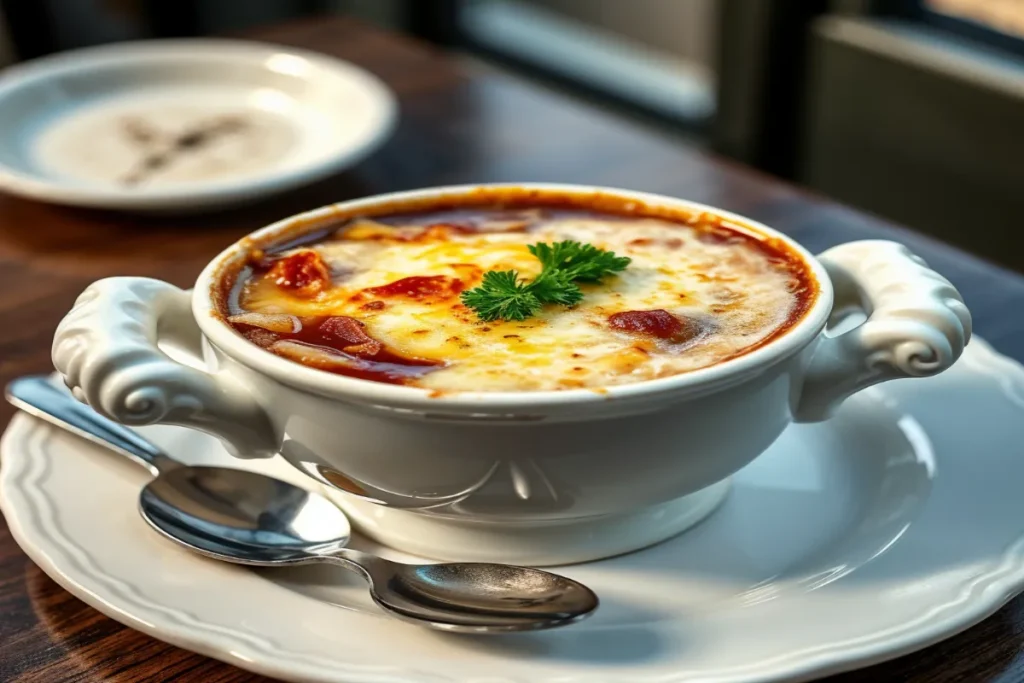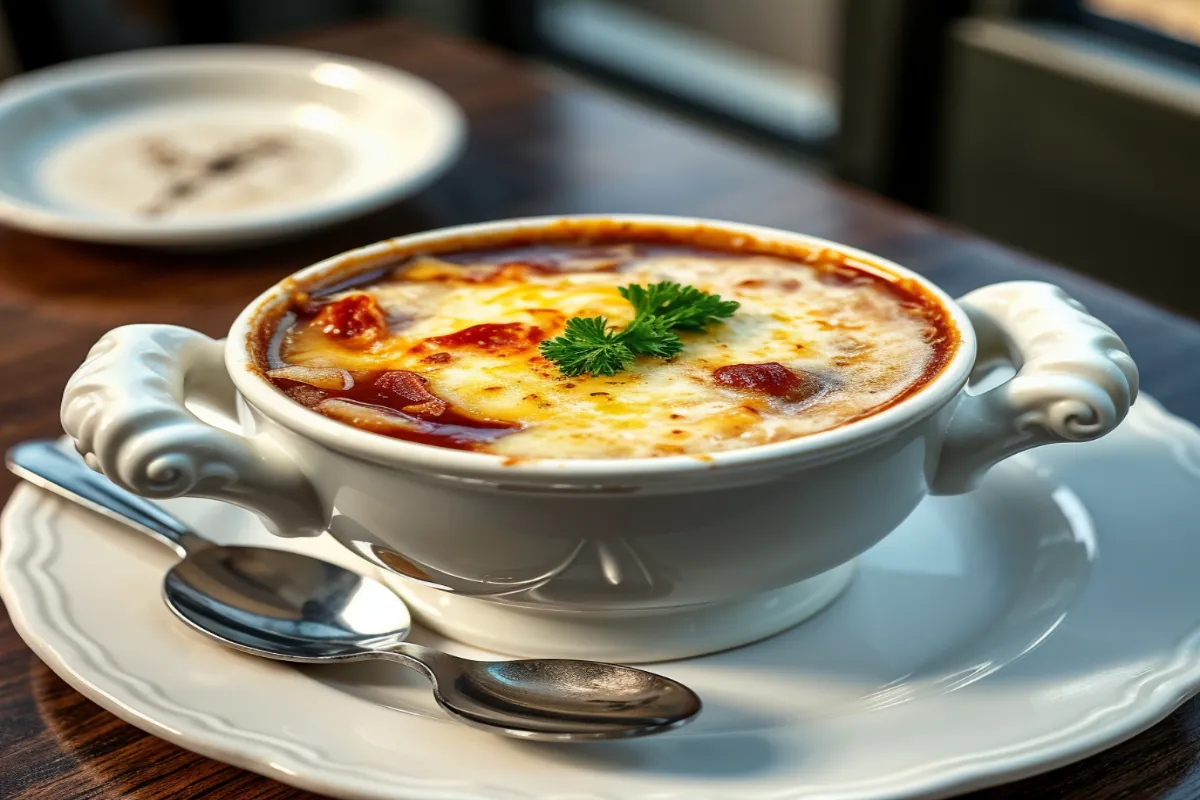
One of the most popular and traditional dishes in French cooking is soupe à l’oignon gratinée. It’s known for its rich, savory flavors and the gooey, golden crust of cheese that tops it. This dish dates back to the Roman Empire but became popular in 18th-century Paris. It has warmed the hearts and homes of many across the globe. But what exactly is the bowl called for French onion soup? And why is it so important? Let’s explore this essential aspect of one of the world’s most comforting soups and see how the right bowl can truly make all the difference.
The Lion’s Head Bowl: A Traditional Choice
When serving French onion soup, many chefs and home cooks opt for the Lion’s Head Bowl. This classic choice enhances the experience of enjoying soupe à l’oignon gratinée. But why is it called the Lion’s Head Bowl? And what makes it the preferred choice for this dish?
The name “Lion’s Head Bowl” comes from the decorative lion’s head handles on either side of the bowl. These handles are not just ornamental; they provide a practical grip, making it easier to carry the bowl from the oven to the table. Moreover, the design ties deeply to French history, where the lion symbolizes strength and nobility. These bowls, traditionally made from porcelain, ceramic, or stoneware, have thick walls that help retain heat. This feature ensures that the soup stays hot throughout the meal.
Explore a savory twist on the classic recipe by reading about French onion soup with rice here.
French Dining Traditions and the Lion’s Head Bowl
The Lion’s Head Bowl carries a storied history rooted in French culinary traditions. In the 18th century, French aristocrats used these bowls as part of their elaborate table settings. During this time, ornate tableware symbolized status and refinement. Furthermore, the lion’s head, representing strength and nobility, became a popular motif in European art and design. It served as a fitting adornment for tableware in the homes of the wealthy.
These bowls were more than just functional; they represented the height of fashion in French dining. They often appeared as part of larger sets that included tureens, platters, and other serving dishes. All were designed to impress guests with the quality of the food and the elegance of the presentation. Over time, people began associating the Lion’s Head Bowl with French onion soup. This dish has roots in the 17th century but gained widespread popularity in the 19th century as a comfort food enjoyed by people across social classes.
Learn more about the history of French onion soup itself, which gives context to the bowl’s significance.
Today, the Lion’s Head Bowl remains a cherished item in both professional and home kitchens. Its perfect blend of practicality and beauty continues to enhance the presentation and enjoyment of French onion soup.
Why This Bowl Stands Out
Using a Lion’s Head Bowl offers more than a nod to tradition. Indeed, it achieves the perfect balance of form and function. This bowl provides the durability and heat retention needed to enjoy every last drop of French onion soup. The bowl’s wide rim plays a crucial role in the final broiling step, where the cheese melts to a bubbly, golden brown. This wide surface area ensures even distribution of the cheese, creating that signature crust that makes French onion soup so delectable.
Additionally, the thick walls of the Lion’s Head Bowl ensure that the soup stays warm for an extended period, allowing you to savor it slowly. This quality is particularly important for French onion soup, as the layers of flavors—rich broth, caramelized onions, and melted cheese—taste best when warm. Furthermore, the bowl’s depth perfectly accommodates the layers of soup, bread, and cheese, ensuring that each spoonful delivers a perfect blend of all these elements.
Beyond its functional benefits, the Lion’s Head Bowl adds a touch of elegance to the dining experience. The ornate design, with its historical and cultural significance, makes the dish feel special, whether you’re serving it at a dinner party or enjoying it on a cozy evening at home.
Choosing the Right Bowl for Serving Soup
When selecting a bowl for French onion soup, there are several factors to consider. The right bowl should be deep enough to hold the soup, bread, and cheese layers while retaining heat to keep the soup warm throughout the meal. Let’s take a closer look at what makes the best bowl for this comforting dish.
The Importance of Material in Soup Bowls
The material of the bowl is crucial. Ceramic and stoneware are the most popular choices. These materials offer excellent heat retention and resist thermal shock. Therefore, they can withstand the high temperatures required for broiling the cheese without cracking. Porcelain is another good option. It provides durability and retains heat well.
Getting the Size and Depth Just Right
The size and depth of the bowl also matter. The bowl should be deep enough to accommodate the soup, bread, and cheese without overflowing. Typically, a capacity of about 12 to 18 ounces is ideal for a single serving. The depth allows for layering, which is essential for achieving the perfect balance of flavors in each bite.
Key Features: Handles and Oven Safety
Handles are essential for safe transport from the oven to the table, especially when the contents are hot. The iconic lion’s head handles are both decorative and practical. They make it easier to carry the hot bowl and add a touch of elegance to the presentation. Additionally, ensure the bowl is labeled as oven-safe. Not all ceramic or porcelain bowls can withstand high heat. This feature is crucial since the final step in preparing French onion soup involves placing the bowl under a broiler to melt and brown the cheese. Oven-safe bowls ensure this step can be completed safely and effectively.
Maintaining Your Bowls: Simple Tips
Proper care and maintenance will keep your French onion soup bowl in excellent condition for years. Therefore, it’s essential to follow these tips to prolong the life of your bowls.
Cleaning Techniques for Longevity
While most ceramic and porcelain bowls are dishwasher safe, hand washing is recommended. Hand washing helps prevent potential damage. Use a gentle detergent and avoid abrasive scrubbers that can scratch the surface. If food sticks to the bowl, soak it in warm soapy water before gently scrubbing.
Protecting Your Bowls from Thermal Shock
Thermal shock can crack your bowls. To prevent this, avoid placing a cold bowl directly into a hot oven. Instead, allow the bowl to warm up gradually to prevent cracking. Similarly, avoid placing a hot bowl directly onto a cold surface. If you need to move a hot bowl, place it on a wooden or fabric trivet to protect it from sudden temperature changes.
Proper Storage for Soup Bowls
Proper storage is important to prevent chipping and damage. Stack your bowls carefully. If stacking isn’t an option, use bowl protectors or cloth between bowls. This practice will help prevent scratches and other damage, keeping your bowls in pristine condition. Store your bowls in a cool, dry place to avoid moisture damage.
Regular Inspections for Long-Lasting Use
It’s also wise to regularly inspect your bowls for signs of wear or damage, such as hairline cracks or chips. Even small imperfections can worsen over time, so it’s best to address them early. This practice will help extend the life of your bowls and keep them functional and beautiful.
Creative Ways to Use Your French Onion Soup Bowls
French onion soup bowls are versatile kitchen tools. While they are perfect for soup, they have many other uses. Let’s explore some creative ways to use your Lion’s Head Bowl or any other deep, oven-safe bowl.
Serving More Than Just Soup
The heat retention properties of these bowls make them ideal for serving other hearty soups, such as clam chowder, minestrone, or beef stew. The deep design allows for a generous portion. Consequently, these bowls are perfect for any soup that benefits from staying warm. They also work well for serving chili, where the wide rim can hold toppings like cheese and sour cream.
Perfect for Baking and Desserts
These bowls are also great for baking desserts. Use them for cobblers, molten chocolate cakes, or bread pudding. The oven-safe nature of these bowls makes them ideal for desserts that require baking. Serving a rich chocolate lava cake in one of these bowls not only adds a touch of elegance but also ensures the dessert stays warm and delicious.
Single-Serve Dishes for All Occasions
The depth and durability of these bowls make them perfect for single-serve casseroles. Dishes like mac and cheese, pot pies, or baked pasta work beautifully in these bowls. They can be taken immediately out of the oven and served.The individual serving size also adds a special touch to dinner parties, allowing each guest to have their own beautifully presented dish.
Appetizers and Sides with Style
These bowls are also useful for serving appetizers, side dishes, or even dips at parties. Their elegant design adds a touch of class to any meal presentation. For example, use them to serve a warm spinach artichoke dip or a hearty portion of roasted vegetables.
Elevate Your Breakfast Experience
Finally, these bowls are great for breakfast dishes. Serve oatmeal, baked eggs, or even a breakfast casserole. The deep sides keep everything contained, and the bowl’s ability to retain heat means your breakfast stays warm as you enjoy it.

